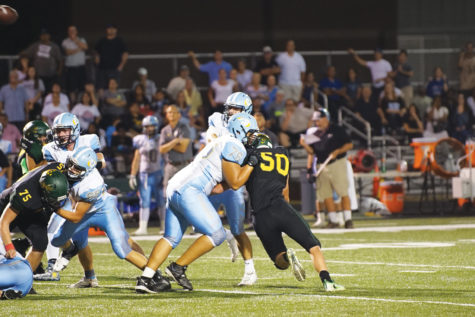Low numbers force sophomore football cancellation

Photo by Richard Chu
When sophomore Andrew Koulogeorge first entered Glenbrook North as a freshman, he never imagined that by his sophomore year he would be on the varsity football team. That all changed this summer when he found out there would be no sophomore football team, resulting in him moving directly to varsity.
“I was excited [when I found out] because I knew that I would have the opportunity to go and show the varsity coaches what I could do,” Koulogeorge said.
Athletic Director John Catalano said the decision to cut the sophomore team came down to a lack of numbers, resulting in Koulogeorge and 13 other sophomores being placed directly on the varsity team.
“Last year, the [current sophomore class] had low numbers, and, actually, the feeder program coming into us had low numbers,” Catalano said.
GBN was one of the last schools to get rid of a sophomore team in the CSL North, which currently has no sophomore level football teams across all of its schools. Both Niles North and Niles West of the CSL South have lost their sophomore teams as well, Catalano said.
Decreasing numbers in high school football have been seen across the nation. According to the National Federation of State High School Associations’s website, participation numbers in football were down 2.1 percent between 2015-2016 and 2016-2017, dropping 23,238 participants from 1,082,637 to 1,059,399. Despite the decrease, football remains the most popular high school sport in the country, having over 400,000 more participants than boys outdoor track and field, which is the second most popular.
Catalano said tryout numbers are more indicative of participation than the number of team members.
“Boys basketball is a good example,” said Catalano. “[For]freshman boys basketball, I remember 75, 80 kids trying out. Now, it’s 50 for the 24 spots.”
Catalano said he attributes the decrease at GBN to a shrinking school size, lack of participation in the youth and feeder levels across multiple sports and, for football specifically, the growing publicity of concussions and head injuries.
“I think the factor of the publicity of the concussions that has filtered down through the NFL has adversely affected kids and families making the decision to participate,” Catalano said.
Football Head Coach Bob Pieper believes concussions and head injuries are often discussed due to the popularity of football, but the sport is the safest it has ever been.
“Of course there’s still risk,” said Pieper. “I’m not going to say it’s safe, but it’s safer because of the way we practice, the knowledge of the kids, the knowledge of the trainers, the knowledge of the coaches and [how] the IHSA is regulating how we do things.”
Koulogeorge said he believes the fear of head injuries is not something players worry about while playing, although he knows people who have had to quit because of them.
“Head injuries we all know [are]an issue, but the trainers are really good about making sure we are being very cautious about [them],” said Koulogeorge. “The coaching staff prepares us well to keep our heads up when we do form tackling. All of us are aware of the consequences, but none of us are necessarily worried.”
Pieper said the lack of a sophomore team has led to a varsity team of 61 players, up from a typical 45-50. At first, Pieper was not a fan of the current arrangement but has grown to like how the larger number allows for greater flexibility in practices, making them better for players and coaches.
“We’ve got 10 coaches, … so we’ve got more eyes on everything,” said Pieper. “We’ve got better drill work. We can do more stuff, … so we get more kids active. In the past when you’d have offense versus defense, there [would] be some kids standing. Now, it’s offense versus defense [on one side] and offense versus defense [on the other], and everyone is doing something.”
Although the current sophomore grade has low participation levels, Pieper said he believes the numbers will return to normal in future years due to strong freshmen participation, but they may still not be able to field a sophomore team because there would be nobody to play against.
Koulogeorge said he enjoys playing on the varsity team rather than the sophomore team, and playing against older and stronger competition will enhance his progression, helping him in the future.
“Guys like [the current seniors] on the team really show you how to [play],” said Koulogeorge. “I really think the extra year of experience is going to help me so much when I [am] a senior to be able to show the juniors or sophomores that are on the varsity team how to lead and win football games.”

